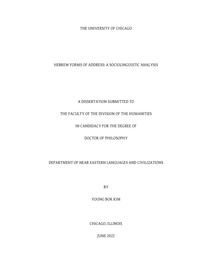In this dissertation, I examine terms of address in Biblical Hebrew (BH) and Epigraphic Hebrew (EH). Every language has its own address system. These systems provide some of the best clues to societal relationships and social structure. For example, many European languages have a so-called T/V pronoun distinction to convey varying levels of intimacy, distance, age, politeness, and/or insult toward the addressee (e.g., tu and vous in French, du and Sie in German). Languages such as modern English have no such T/V distinction but employ functional equivalents to show these attitudes toward the addressee (e.g., by using first name or by honorific title sir or ma’am). BH and EH are similar to English in showing no pronominal T/V distinction. However, various terms of address are employed to index social relationships between speaker and addressee. This dissertation aims to answer four main questions: (1) What are the terms of address in BH and EH?; (2) What are the discernible distribution patterns in the BH and EH address system?; (3) How do noticeable variations in the use of terms of address contribute to our understanding of social factors, such as social status, age, gender, speaker’s attitude to addressee, or chronological periods?; (4) How are those variations exegetically significant? Previous studies on Hebrew terms of address are few in number and they do not treat the subject comprehensively. The definition and categories of terms of address developed in sociolinguistic studies have not been adequately applied to ancient Hebrew. A comprehensive sociolinguistic study that systematically presents the use of Hebrew terms of address in various social interactions is still lacking. This dissertation is designed to fill that gap.
Friday, January 13, 2023
Hebrew Forms of Address: A Sociolinguistic Analysis
Subscribe to:
Post Comments (Atom)










 Stumble It!
Stumble It!

No comments:
Post a Comment